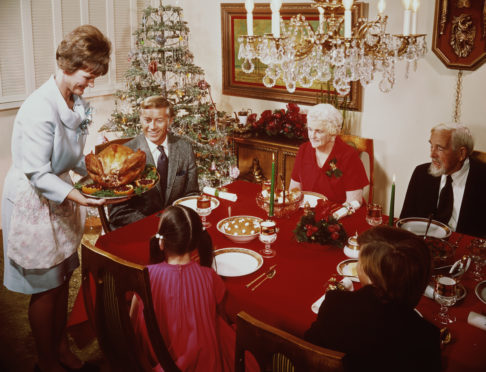Such a bittersweet month, December: the delicate scent of clementine oranges and the silvery flash of tinsel and the dance of fairy lights in the winter dark, all of it threaded together with the cheer of a Christmas yet to come and the aching, aching nostalgia of all the Christmases gone by.
It’s a month for being a parent, of consciously gathering your brood around, yet somehow that grown-up feeling is infused with being a child again, and the memory of parents and what they once did.
The ghost of my decoration-loving father hovers over the old-fashioned glass baubles when I pull the dusty Christmas box from its hiding place; the ghost of my mother whispers in my ear in the supermarket as I begin the annual squirrelling of items that will come in handy over the festive season.
“Grandma lives!” says my daughter with a delicious, malicious glint in her eye that would have been worthy of the old girl herself. She likes to tease that I am becoming like my mother. Moll was eccentric, acerbic, sometimes hilariously snotty – and bafflingly irrational for a smart dame. Not like me at all.
I protest every time she says it, remembering the arrogance of my youth and the feeling that however my life turned out, it would be different to the old guys. Better. In a shop, I spot a card that I buy for my daughter and give with equivalent relish to hers. It has a picture of an eccentric old lady on it and a younger, identikit version beside her. “No matter how hard you try,” it says, “you end up like your mother.” No escape, dear.
There’s something in that: the rolling of the generations; the relentlessness of time; our place in the cycle. Christmas is always a reminder. Perhaps it’s because the Christmas story is essentially the story of parents and children. “The Holy Family” as we were taught to say reverently as children, and didn’t we say it with such innocent belief? A baby in a manger, steadfast parents keeping guard, and bright stars from the east.
All a reflection, of course, of the ultimate parental relationship: God the Father and his children.
Well, I don’t know about any of that, though I can hope in it. The religious belief got harder and, ultimately, my journalistic career got entwined with uncovering sexual abuse in the church and perhaps worse, continued abuse of power. The staggering cruelty and ruthlessness involved buffeted the remnants of a precarious faith, leaving it flickering like a candle flame in the wind. Somehow, in December, it feels like the embers glow a little fiercer. The Christmas cocktail is a potent mix of tradition and novelty with a great big splash of magic.
In the first moments of a December morning, when the kitchen is quiet and cold still, it all comes flooding back. The coffee machine is whirring but the years are spinning back, and I am walking through snow to church on Christmas Eve as midnight approaches. My mother and father are there, solid and real again, and there is nothing to fear. The snowflakes are swirling and I want to be home again, but there is safety deep inside because they are there, and there is the promise of my mother’s home-made sausage rolls and mince pies on our return. And when, as an adult, that feeling of safety goes, the instinct is to provide it for your own children – and maybe re-create the illusion for yourself in the process.
If you have lost someone this year, Christmas will be especially poignant. But there is something so life-affirming about this time, the gentleness of the sentiments, the special kind of peace that doesn’t exist at other times of year, that it is worth seizing the moment for what it is, celebrating it not with a sense of loss but a sense of the presence of those who are no longer here, celebrating for them and with them. Perhaps the greatest thing Christmas brings is a sense of hope and optimism when we don’t even know what we are hoping for, or in.
Invariably on winter mornings, there are words from a Thomas Hardy poem, “The Oxen” that run through my mind. I might not think about them in any other month, but every Christmas, they come back to me. If each month is a verse of that year’s song, Hardy’s words provide my December chorus. Describing the nativity, Hardy reflects that, “so fair a fancy few would weave in these years!” (And how much more true that is in our own times.) Yet, somehow, the lure of ‘the fancy’ never quite dies. Maybe, when it boils down to it, we are all agnostics trying to make sense, and perhaps there’s even some comfort in that.
“…..Yet, I feel,” Hardy writes,
“If someone said on Christmas Eve,
Come; see the oxen kneel…
I should go with him in the gloom,
Hoping it might be so.”
Catherine Deveney is an award-winning investigative journalist, novelist and television presenter

